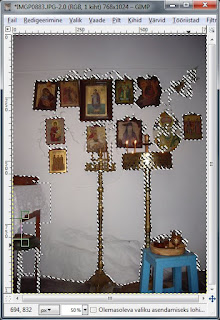Workflow
Let's start with two images of stone wall we want to merge into one texture:
 |
| First image - a plain wall |
 |
| Second image - a corner made of bricks |
As you can see (among other things) the images have a bit different colors - the first one has more contrast and red. The bright background of the second picture influenced camera color adjustment logic so that the wall is more gray and has less contrast.
We will correct this automatically. First we move both photos to the same image (not necessary, but easier to compare) and add masks. We mask out all details that we do not want to influence final color - i.e. roof, shaded areas, brick structures, grass and background.
 |
| Masked images on top to each other. |
Next we select the masked layer whose colors we want to change (Layer 2), invoke TextureWerke and choose color matching mode.
 |
| TextureWerke dialog window in color mode |
Template is the (masked) layer whose color profile we want to emulate in selected layer.
Blurring reduces the noisiness of distribution curves and thus helps to overcome artefacts resulting from different sharpness of images. On the other hand it may mask out certain differences in color distribution and thus reduce the matching quality. You can always try and use what gives the best results.
And at last we apply the filter.
 |
| Image with adjusted colors |
As you can see, the overall color and contrast of the (stone part of) wall matches with template image. On the other hand the areas that were masked out (bricks, backround...) are now completely off. But probably we did not want to use these anyways - except bricks maybe - but these can easily be copied and pasted from the original, and adjusted separately.
FYI: Internally the algorithm works by comparing pairwise the cumulative distributions of each image channel (R,G,B,A) and building a transfer function that translates the values with one distribution to the values with another (template) distribution.
And that's all. Have fun!





